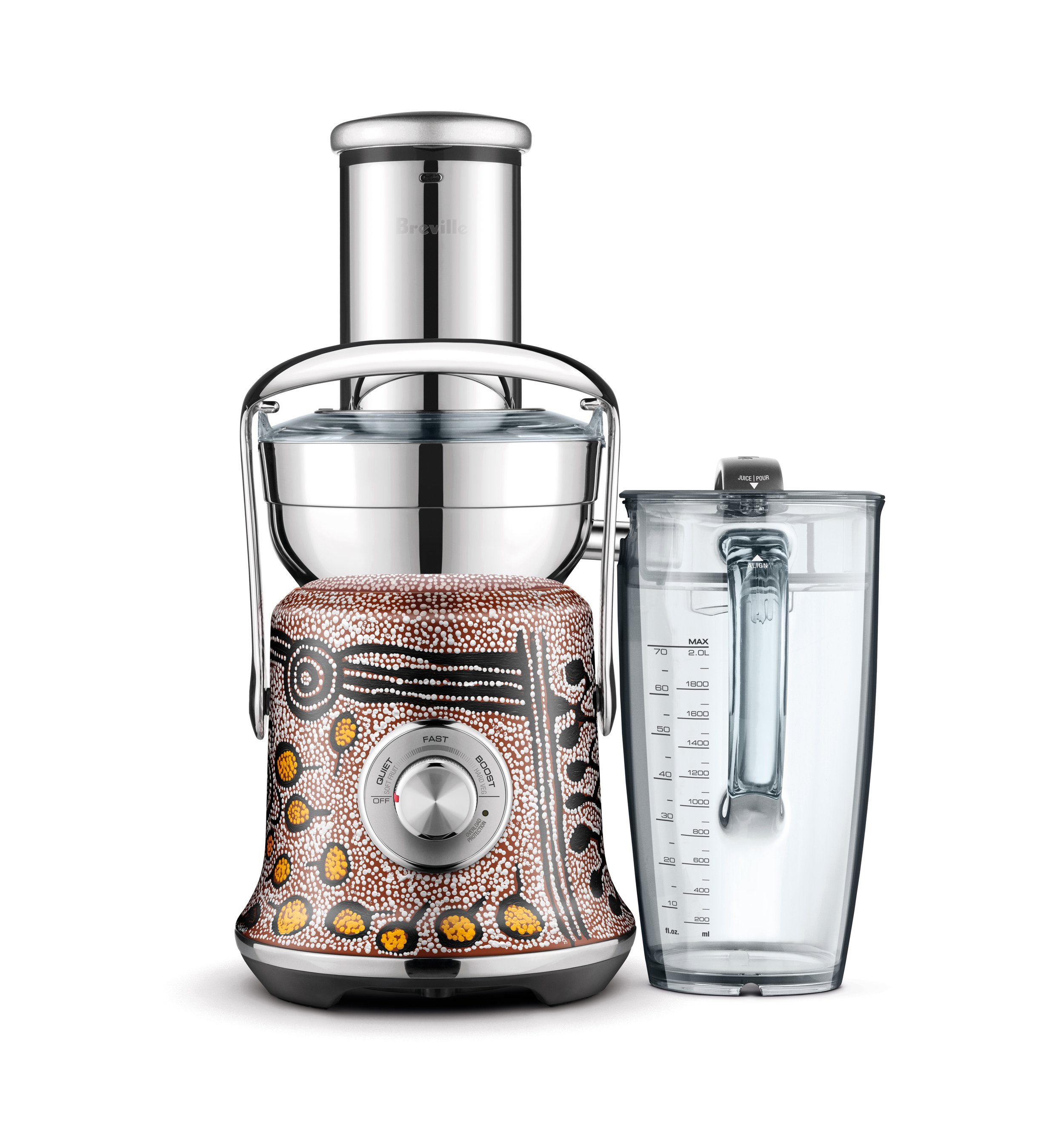An Aboriginal Australian Culinary Journey
Breville teams up with Australia’s first-ever artists for its An Aboriginal Australian Culinary Journey collection to present 65,000 years of the world’s oldest living food culture.
Photography: Courtesy of Breville
'Our artists, Yalti, Yukultji, Warlimpirrnga and Lucy embraced this project so effortlessly and intuitively and imbued so much story and meaning to each piece. I am so proud to be part of this rich and important chapter in Australian design and culinary history,' says Alison Page, Curator.
Kampurarrpa Dreaming at Ngami Juicer by Yalti Napangati.
A decade in the making, An Aboriginal Australian Culinary Journey combines ancient stories with the best of contemporary design, with 100% of Breville’s profits from the collection going to the National Indigenous Culinary Institute of Australia and other initiatives supporting the creation of opportunity for Aboriginal and Torres Strait Islander people.
“Living in the heart of people’s homes these once everyday objects, now wrapped in Country, become cultural ambassadors This is what makes the Aboriginal Culinary Journey collection so significant—it’s more than just a product, it’s a piece of our culture and Country in the same way we buy art on canvas for our homes.”
What began as a seed planted in a simple conversation evolved into a passion project to pay tribute to some of the nation’s most talented artists and creatives to educate Australians about ancient Indigenous beliefs and practices through art..
Dhunbarrbil Place of many seeds ready for grinding Toaster by Lucy Simpson.
Piruwa Women preparing Piruwa tea at Kiwirrkurra Kettle by Yalti Napangati.
Artist Lucy Simpson at work on the Dhunbarrbil Toaster.
Aboriginal designer and curator Alison Page, together with global leader in innovative appliances, Breville, has achieved a world first collaboration—partnering with First Nations People and the National Museum of Australia to create products for the heart of the home that celebrate contemporary design and reflect 65,000 years of ongoing Australian Indigenous Culture.
A decade in the making, An Aboriginal Australian Culinary Journey combines ancient stories with the best of contemporary design, with 100% of Breville’s profits from the collection going to the National Indigenous Culinary Institute of Australia and other initiatives supporting the creation of opportunity for Aboriginal and Torres Strait Islander people.
Breathing art, ritual and stories into our homes and everyday lives, the inaugural limited series of products, including a coffee machine, toaster, juicer, oven and kettle, feature works by esteemed Western Desert artists, and members of the original; Pintupi Nine, Yalti Napangati, Yukultji Napangati, Warlimpirrnga Tjapaltjarri and Sydney-based artist and Yuwaalaraay woman, Lucy Simpson.
The journey began back in 2006, when Alison approached Richard Hoare, Breville’s design and innovation director, to start a conversation about bringing Indigenous art to life on products and speak to people in their homes through the narrative power of visual storytelling. What began as a seed planted in a simple conversation evolved into a passion project to pay tribute to some of our nation’s most talented artists and creatives to educate Australians about ancient Indigenous beliefs and practices through art on kitchen objects.
‘When it comes to food preparation and cooking, Indigenous Australians have been at it longer than most. But when we step into a modern kitchen, it’s easy to forget that our wondrous appliances provide the same service that our ancient ancestors' campfires, grinding stones and stone age tools did over millennia,’ says Alison. ‘Their stories are told by symbols and stories, which are painted, burned, and etched into their objects.'
The National Museum of Australia will feature the limited series in an exhibition, An Aboriginal Culinary Journey: Designed for Living, focusing on the continuity of cultural mark-making associated with Indigenous food culture by pairing First Nations traditional tools for living alongside the six modern kitchen objects also richly marked with signs of Country and culture.
‘Art, like ceremony, is a form of storytelling, a critical way of passing on knowledge from ecology to law. It’s our science, medicine, healing, engineering, geology; almost all the disciplines that you will have in the Western world are practiced through art and ceremony. Elders tell us Country can’t speak for itself. We, the artists, must speak for Country. Art is the tongue for Country,’ says Margo Ngawa Neale, Head of the Centre for Indigenous Knowledge, Senior Indigenous Curator and Advisor, The National Museum of Australia.
‘Living in the heart of people’s homes these once everyday objects, now wrapped in Country, become cultural ambassadors This is what makes the Aboriginal Culinary Journey collection so significant – it’s more than just a product, it’s a piece of our culture and Country in the same way we buy art on canvas for our homes. We have always made marks of meaning on our tools for living, so this idea is just keeping up with the times,’ she adds.
An Aboriginal Australian Culinary Journey is available now. Follow @brevilleaus on Instagram.











